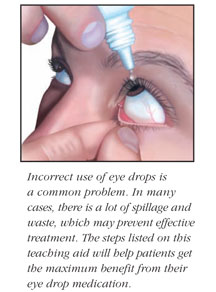
Incorrect Use Wastes Eye Drops
Eye drops are used to treat many common conditions. They may be used for itchy or tired eyes as in allergies. They may be prescribed for viral or bacterial infections or other conditions such as glaucoma. When eye drops are not administered (used) properly the full benefit of the medication may not be realized. If the drop does not fall directly onto the eye, then there will be waste because it will roll down the cheek or into the tear duct. The lower lid should be pinched slightly and pulled down and out to form a pocket. To release a drop, turn the container upside down and squeeze. Some people find this difficult. You may try lying down and then pulling the lower eyelid to form the pocket. The easiest solution is to have someone else administer the drops. Remember to wash your hands before and after administering the drops. It is very important to remember that the dropper should NOT touch the eye or your fingers. This might contaminate the eye drops. Eye drops should never be shared with anyone. Follow the directions on the label and ask the pharmacist to help you understand how to use them. Most eye drops are stored in a cool dry place and should not be used longer than one month after the bottle is opened, unless otherwise stated on the label. Your pharmacist may recommend a nonprescription eye drop if appropriate for your problem and can answer any questions you may have about prescription or over-the counter eye drops.
The Proper Way to Use Drops
Almost everyone has used eye drops at some time—perhaps to treat an eye infection, to rewet contact lenses, to soothe dry or irritated eyes, or prior to or after eye surgery. There is a right way to use eye drops, although many people administer the drops incorrectly, resulting in spillage and waste. The following list of steps will help patients get the maximum benefit from their eye drops.
Follow These 7 Steps:
- Always wash your hands first before administering eye drops.
- Shake the bottle if indicated on the label. If the bottle has been refrigerated, warm it between your hands to room temperature.
- Gently clean the eyelids if they are crusty with discharge by wiping the lid from the inner corner to the outer corner with the eye closed using with a cotton ball dampened with warm water.
- Tilt back the head, or lie down, and look upward. Using the thumb and index finger, gently pinch and pull the lower eyelid downward to form a pocket.
- Place the eye drop or drops into the pouch formed in the lower lid, not directly into the eye. If an eye ointment is used, place a 1/4 inch line of ointment into the lower lid pouch. Be careful that the dropper or ointment tube does not touch the eye.
- Close your eye gently for 1 to 3 minutes or as instructed by the doctor to allow the medication to be absorbed. Some doctors recommend pressing the finger against the inner corner of the eye to keep the medication from going into the tear duct.
- If another drop of eye medication is needed, wait at least 5 to 10 minutes before administering the second eye drop so the first drop will not be washed out of the eye. The small pouch formed by the lower lid will only hold one drop at a time, and extra drops will either flow into the tear duct (and out of the eye) or down the face.
Other Helpful Hints for the Proper Use of Eye Drops or Ointments
- Check the label on your eye drop or ointment to see if refrigeration is necessary.
- Always recap the bottle or tube immediately after use. Never wipe or rinse the tip of the dropper to avoid contamination.
- Many eye medications cause a slight stinging sensation after instillation. Tell your doctor if this sensation lasts more than a minute or two.
- Eye ointments cause a blurring of vision. This is normal, and should go away in a few minutes.
- Never wear contact lenses while using eye drops or ointments unless instructed to do so by your doctor.
- If you are told to use an eye drop and an eye ointment at the same time, use the eye drop first, wait a few minutes, and then use the ointment.






